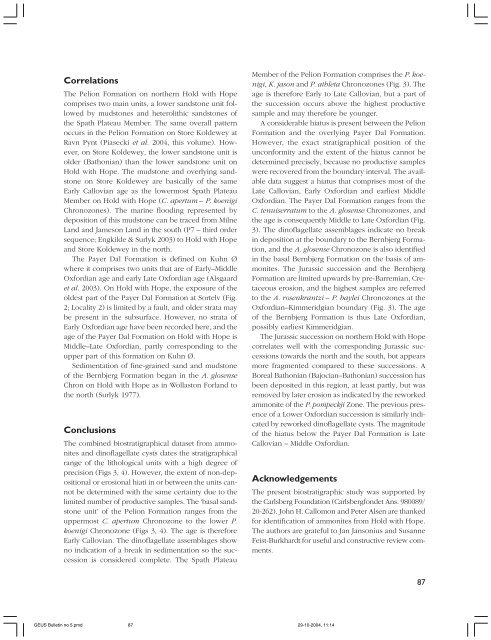GEUS Bulletin no 5.pmd
GEUS Bulletin no 5.pmd
GEUS Bulletin no 5.pmd
Create successful ePaper yourself
Turn your PDF publications into a flip-book with our unique Google optimized e-Paper software.
Correlations<br />
The Pelion Formation on <strong>no</strong>rthern Hold with Hope<br />
comprises two main units, a lower sandstone unit followed<br />
by mudstones and heterolithic sandstones of<br />
the Spath Plateau Member. The same overall pattern<br />
occurs in the Pelion Formation on Store Koldewey at<br />
Ravn Pynt (Piasecki et al. 2004, this volume). However,<br />
on Store Koldewey, the lower sandstone unit is<br />
older (Bathonian) than the lower sandstone unit on<br />
Hold with Hope. The mudstone and overlying sandstone<br />
on Store Koldewey are basically of the same<br />
Early Callovian age as the lowermost Spath Plateau<br />
Member on Hold with Hope (C. apertum – P. koenigi<br />
Chro<strong>no</strong>zones). The marine flooding represented by<br />
deposition of this mudstone can be traced from Milne<br />
Land and Jameson Land in the south (P7 – third order<br />
sequence; Engkilde & Surlyk 2003) to Hold with Hope<br />
and Store Koldewey in the <strong>no</strong>rth.<br />
The Payer Dal Formation is defined on Kuhn Ø<br />
where it comprises two units that are of Early–Middle<br />
Oxfordian age and early Late Oxfordian age (Alsgaard<br />
et al. 2003). On Hold with Hope, the exposure of the<br />
oldest part of the Payer Dal Formation at Sortelv (Fig.<br />
2; Locality 2) is limited by a fault, and older strata may<br />
be present in the subsurface. However, <strong>no</strong> strata of<br />
Early Oxfordian age have been recorded here, and the<br />
age of the Payer Dal Formation on Hold with Hope is<br />
Middle–Late Oxfordian, partly corresponding to the<br />
upper part of this formation on Kuhn Ø.<br />
Sedimentation of fine-grained sand and mudstone<br />
of the Bernbjerg Formation began in the A. glosense<br />
Chron on Hold with Hope as in Wollaston Forland to<br />
the <strong>no</strong>rth (Surlyk 1977).<br />
Conclusions<br />
The combined biostratigraphical dataset from ammonites<br />
and di<strong>no</strong>flagellate cysts dates the stratigraphical<br />
range of the lithological units with a high degree of<br />
precision (Figs 3, 4). However, the extent of <strong>no</strong>n-depositional<br />
or erosional hiati in or between the units can<strong>no</strong>t<br />
be determined with the same certainty due to the<br />
limited number of productive samples. The ‘basal sandstone<br />
unit’ of the Pelion Formation ranges from the<br />
uppermost C. apertum Chro<strong>no</strong>zone to the lower P.<br />
koenigi Chro<strong>no</strong>zone (Figs 3, 4). The age is therefore<br />
Early Callovian. The di<strong>no</strong>flagellate assemblages show<br />
<strong>no</strong> indication of a break in sedimentation so the succession<br />
is considered complete. The Spath Plateau<br />
Member of the Pelion Formation comprises the P. koenigi,<br />
K. jason and P. athleta Chro<strong>no</strong>zones (Fig. 3). The<br />
age is therefore Early to Late Callovian, but a part of<br />
the succession occurs above the highest productive<br />
sample and may therefore be younger.<br />
A considerable hiatus is present between the Pelion<br />
Formation and the overlying Payer Dal Formation.<br />
However, the exact stratigraphical position of the<br />
unconformity and the extent of the hiatus can<strong>no</strong>t be<br />
determined precisely, because <strong>no</strong> productive samples<br />
were recovered from the boundary interval. The available<br />
data suggest a hiatus that comprises most of the<br />
Late Callovian, Early Oxfordian and earliest Middle<br />
Oxfordian. The Payer Dal Formation ranges from the<br />
C. tenuiserratum to the A. glosense Chro<strong>no</strong>zones, and<br />
the age is consequently Middle to Late Oxfordian (Fig.<br />
3). The di<strong>no</strong>flagellate assemblages indicate <strong>no</strong> break<br />
in deposition at the boundary to the Bernbjerg Formation,<br />
and the A. glosense Chro<strong>no</strong>zone is also identified<br />
in the basal Bernbjerg Formation on the basis of ammonites.<br />
The Jurassic succession and the Bernbjerg<br />
Formation are limited upwards by pre-Barremian, Cretaceous<br />
erosion, and the highest samples are referred<br />
to the A. rosenkrantzi – P. baylei Chro<strong>no</strong>zones at the<br />
Oxfordian–Kimmeridgian boundary (Fig. 3). The age<br />
of the Bernbjerg Formation is thus Late Oxfordian,<br />
possibly earliest Kimmeridgian.<br />
The Jurassic succession on <strong>no</strong>rthern Hold with Hope<br />
correlates well with the corresponding Jurassic successions<br />
towards the <strong>no</strong>rth and the south, but appears<br />
more fragmented compared to these successions. A<br />
Boreal Bathonian (Bajocian–Bathonian) succession has<br />
been deposited in this region, at least partly, but was<br />
removed by later erosion as indicated by the reworked<br />
ammonite of the P. pompeckji Zone. The previous presence<br />
of a Lower Oxfordian succession is similarly indicated<br />
by reworked di<strong>no</strong>flagellate cysts. The magnitude<br />
of the hiatus below the Payer Dal Formation is Late<br />
Callovian – Middle Oxfordian.<br />
Ack<strong>no</strong>wledgements<br />
<strong>GEUS</strong> <strong>Bulletin</strong> <strong>no</strong> <strong>5.pmd</strong> 87<br />
29-10-2004, 11:14<br />
The present biostratigraphic study was supported by<br />
the Carlsberg Foundation (Carlsbergfondet Ans. 980089/<br />
20-262). John H. Callomon and Peter Alsen are thanked<br />
for identification of ammonites from Hold with Hope.<br />
The authors are grateful to Jan Jansonius and Susanne<br />
Feist-Burkhardt for useful and constructive review comments.<br />
87

















